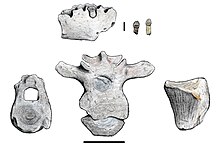| Antarctopelta Temporal range: Maastrichtian, Late Cretaceous
| |
|---|---|

| |
| Sketches of the holotype | |
| Scientific classification | |
| Domain: | Eukaryota |
| Kingdom: | Animalia |
| Phylum: | Chordata |
| Clade: | Dinosauria |
| Clade: | †Ornithischia |
| Clade: | †Thyreophora |
| Clade: | †Ankylosauria |
| Clade: | †Parankylosauria |
| Genus: | †Antarctopelta Salgado & Gasparini, 2006 |
| Type species | |
| †Antarctopelta oliveroi | |
Antarctopelta (ann-TARK-toh-PEL-tə; meaning 'Antarctic shield') is a genus of ankylosaurian dinosaur, a group of large, quadrupedal herbivores, that lived during the Maastrichtian stage of the Late Cretaceous period on what is now James Ross Island, Antarctica. Antarctopelta is the only known ankylosaur from Antarctica and a member of Parankylosauria. The only described specimen was found in 1986, the first dinosaur to be found on the continent, by Argentine geologists Eduardo Olivero and Robert Scasso. The fossils were later described in 2006 by paleontologists Leonardo Salgado and Zulma Gasparini, who named the type species A. oliveroi after Olivero.
It was a medium-sized ankylosaur, reaching 4 meters (13 feet) in length or more, and showed characteristics of two different families, making more precise classification difficult for many years. This was until 2021, when a nearly complete skeleton of the similar Chilean genus Stegouros was described. This led to the recognition of Parankylosauria, containing Antarctopelta, Stegouros, and Kunbarrasaurus. The head was small, with proportionally large teeth compared to other ankylosaurs' and spikes above the orbits. The neck and back vertebrae were short and circular in cross-section, whereas the tail vertebrae were elongated and flattened. Its tail likely terminated in an arrangement of spiked osteoderms known as a macuahuitl, which resembled an Aztec weapon of the same name. Osteoderms were present on other parts of the body and came in six different shapes, with some being large and flat while others were tall and keeled.
It was discovered in rocks of the Gamma Member of the Snow Hill Island Formation, which bears a variety of other fossils, many of them unique as they evolved in the isolation of Antarctica after the breakup of Gondwana. Antarctopelta coexisted with the ornithopod dinosaur Trinisaura in addition to a menagerie of mosasaurs, plesiosaurs, and sharks.